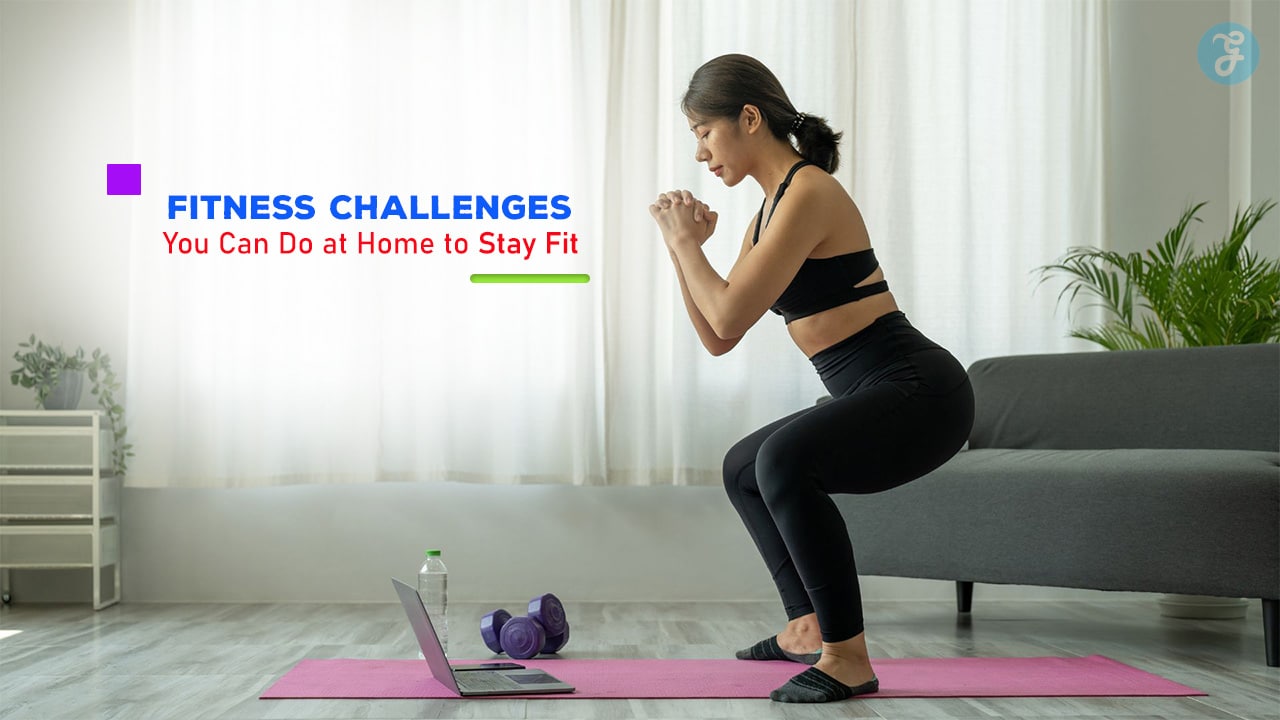Maintaining your fitness from home can be both effective and rewarding, especially with the right challenges to keep you motivated.
Whether you’re looking to build muscle, lose weight, or just stay active, these fitness challenges can help you reach your goals without needing a gym or specialized equipment.
Here’s a comprehensive look at 7 fitness challenges you can do at home to improve strength, endurance, flexibility, and overall fitness.
These challenges are designed for all fitness levels and can be adapted to your specific needs.
1. 30-Day Plank Challenge
Why It’s Effective:
The plank is one of the best exercises for building core strength, which is crucial for improving posture, stabilizing your body, and reducing the risk of injury.
This challenge gradually increases the time you hold a plank each day, helping you build endurance and strength in your core, shoulders, arms, and legs.
Challenge Breakdown:
- Day 1:
Hold a plank for 20 seconds. Focus on maintaining proper form—elbows under your shoulders, body in a straight line from head to heels, and core tight.
- Day 5:
Increase the hold to 40 seconds. At this point, you should start feeling your core engaging more intensely.
- Day 10:
Hold for 1 minute. Ensure you’re not sagging in your lower back, as this can lead to injury.
- Day 20:
Hold the plank for 2 minutes.
As you increase time, you may feel your muscles trembling.
This is a sign of muscle engagement and growth.
- Day 30:
Hold the plank for 3 minutes.
By now, your core strength should have significantly improved, and you should notice better stability and posture in daily activities.
Tips for Success:
- Start with the basic forearm plank, then progress to variations like side planks and plank reaches to target different muscle groups.
- If you’re struggling with longer holds, break the time into sets (e.g., 3 sets of 1-minute planks).
Benefits:
- Builds a strong, stable core.
- Enhances overall body stability and coordination.
- Improves posture and can help reduce back pain.
2. 100 Squats a Day Challenge
Why It’s Effective:
Squats are a compound exercise that works the entire lower body—glutes, hamstrings, quads, and calves—while also engaging the core.
Doing 100 squats a day builds lower body strength, endurance, and muscle tone.
It’s a great challenge for people looking to tone their legs and glutes or improve their mobility and stability.
Challenge Breakdown:
- Day 1-3:
Start by doing 50 squats. This helps ease your body into the routine.
- Day 4-7:
Increase to 75 squats per day. Make sure to perform the exercise slowly and with proper form to avoid injury.
- Day 8-30:
Perform 100 squats each day. You can do this in one session or split it into smaller sets (e.g., 4 sets of 25 squats).
- Optional:
Add variations such as jump squats, sumo squats, or goblet squats to target different muscles and add intensity.
Tips for Success:
- Keep your chest lifted, push your hips back, and ensure your knees don’t go past your toes.
- If 100 squats in one go seems too much, split them into sets throughout the day.
Benefits:
- Tones and strengthens the legs, glutes, and core.
- Improves balance and mobility.
- Boosts calorie burn and promotes muscle endurance.
3. Push-Up Challenge
Why It’s Effective:
Push-ups are a classic bodyweight exercise that strengthens the upper body, including the chest, shoulders, triceps, and core.
This challenge helps you progressively build upper body strength while improving muscular endurance.
Challenge Breakdown:
- Day 1-3:
Start with 10 push-ups, focusing on perfect form.
- Day 4-7:
Increase to 20 push-ups per day. Keep your elbows close to your body to engage the triceps more.
- Day 8-15:
Increase to 30-40 push-ups per day, performed in sets if needed (e.g., 4 sets of 10).
- Day 16-30:
Aim for 50-100 push-ups, split into manageable sets. If you can’t perform them all at once, do smaller sets throughout the day.
Variations:
- Beginner:
Perform push-ups on your knees or against a wall to build strength.
- Advanced:
Try more challenging variations like diamond push-ups, decline push-ups, or explosive (clap) push-ups for added intensity.
Tips for Success:
- Keep your body in a straight line, from head to heels, throughout the movement.
- Focus on engaging your core and glutes to avoid sagging or arching your back.
Benefits:
- Strengthens the chest, shoulders, and triceps.
- Improves core stability and endurance.
- Enhances upper body muscular endurance and definition.
4. 10,000 Steps a Day Challenge
Why It’s Effective:
Walking is one of the easiest and most accessible forms of exercise.
A 10,000-step challenge encourages consistent movement throughout the day, which is especially important for those with sedentary jobs or lifestyles.
Walking improves cardiovascular health, boosts mental well-being, and can help with weight management.
Challenge Breakdown:
- Goal:
Aim to reach 10,000 steps every day. Use a pedometer, fitness tracker, or smartphone app to monitor your steps.
- Split into sessions:
Take short walks throughout the day—morning, lunch, and evening—to hit your goal. Walk around your house or yard if you can’t get outside.
- Boost your step count:
Incorporate more movement into your daily routine by parking further away, taking the stairs, or walking in place during TV commercials.
Tips for Success:
- Pair walking with other activities, like listening to podcasts or audiobooks, to make it more enjoyable.
- Take advantage of any opportunity to move, such as walking during phone calls or pacing during breaks.
Benefits:
- Increases daily physical activity and reduces sedentary time.
- Improves cardiovascular health and burns calories.
- Enhances mood and reduces stress levels.
5. 30-Day Yoga Challenge
Why It’s Effective:
Yoga is a holistic workout that improves flexibility, strength, balance, and mindfulness.
A 30-day yoga challenge encourages consistency and helps develop a regular practice that benefits both body and mind.
Yoga can be done anywhere and requires minimal equipment, making it an excellent choice for at-home fitness.
Challenge Breakdown:
- Day 1-10:
Begin with 15-20 minutes of beginner yoga sessions focusing on foundational poses like Downward Dog, Child’s Pose, and Warrior 1.
- Day 11-20:
Gradually increase the session time to 30 minutes, introducing intermediate poses like Warrior 2, Tree Pose, and Sun Salutations.
- Day 21-30:
Aim for 40-60 minute sessions, incorporating advanced poses like Crow Pose, Half Moon, or even Headstands if you’re ready.
Tips for Success:
- Focus on alignment and breathing rather than trying to push yourself into difficult poses too quickly.
- Use props like yoga blocks or straps if needed to help with flexibility.
Benefits:
- Enhances flexibility and muscle tone.
- Improves mental clarity, focus, and relaxation.
- Reduces stress and promotes overall well-being.
6. High-Intensity Interval Training (HIIT) Challenge
Why It’s Effective:
High-Intensity Interval Training (HIIT) is a time-efficient workout that alternates between intense bursts of exercise and short recovery periods.
HIIT is known to burn fat, improve cardiovascular health, and boost metabolism, making it an ideal challenge for those looking to maximize results in a short amount of time.
Challenge Breakdown:
- Day 1-7:
Start with a 10-minute HIIT session that consists of 20 seconds of work and 40 seconds of rest.
Example exercises include burpees, mountain climbers, and jump squats.
- Day 8-14:
Increase the session time to 15-20 minutes, with a 30/30 work-to-rest ratio.
- Day 15-30:
Push your workout to 25-30 minutes, with a 40/20 work-to-rest ratio, for maximum intensity.
Example Workout:
- 30 seconds of jump squats.
- 30 seconds of rest.
- 30 seconds of burpees.
- 30 seconds of rest.
- 30 seconds of mountain climbers.
- Repeat for 3-5 rounds.
Tips for Success:
- Focus on quality over quantity—make sure each exercise is performed with proper form to avoid injury.
- Adjust the intensity based on your fitness level and gradually increase the difficulty as you progress.
Benefits:
- Burns a high number of calories in a short time.
- Boosts cardiovascular fitness and muscle endurance.
- Increases metabolism for hours after the workout.
7. 7-Day Full-Body Workout Challenge
Why It’s Effective:
A 7-day full-body workout challenge is a short, intensive program designed to target all major muscle groups while building overall strength, endurance, and cardiovascular fitness.
It’s a great way to jumpstart your fitness routine and see quick results.
Challenge Breakdown:
- Day 1:
Upper body workout (push-ups, tricep dips, plank to push-up).
- Day 2:
Lower body workout (squats, lunges, glute bridges).
- Day 3:
Core workout (plank variations, Russian twists, bicycle crunches).
- Day 4:
Full-body circuit (burpees, mountain climbers, jump squats).
- Day 5:
Rest day or active recovery (light stretching, walking, or yoga).
- Day 6:
Cardio and endurance (jumping jacks, high knees, sprint intervals).
- Day 7:
Full-body stretch or yoga flow to recover and relax.
Tips for Success:
- Focus on form and control rather than speed to get the most out of each exercise.
- Include a warm-up and cool-down for each workout to prevent injury and improve recovery.
Benefits:
- Works all major muscle groups for balanced strength and endurance.
- Promotes cardiovascular health and fat loss.
- Provides a complete fitness routine in just one week.
Conclusion
These 7 fitness challenges provide a wide variety of exercises and routines that you can do at home, regardless of your fitness level.
Whether you’re looking to improve strength, build endurance, or increase flexibility, these challenges offer structure, motivation, and gradual progression to help you achieve your goals.
Each challenge can be adjusted to fit your schedule, equipment availability, and personal preferences.
By committing to these challenges, you’ll not only improve your physical fitness but also develop the consistency and discipline needed to maintain a healthy lifestyle in the long term.










































